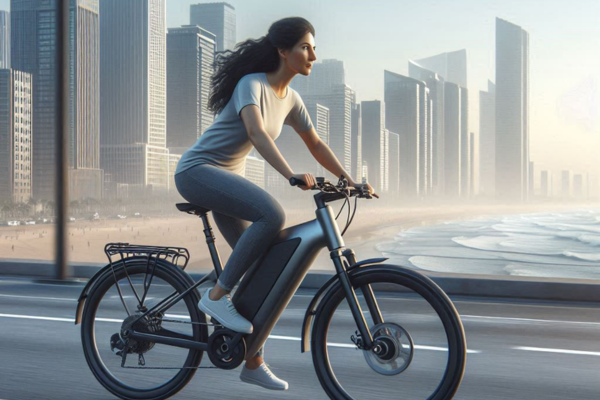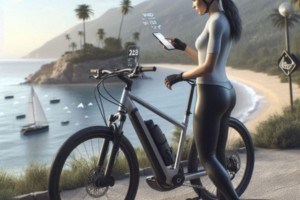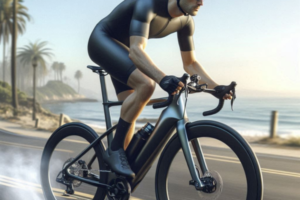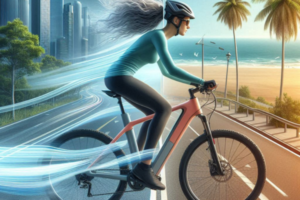🚴♂️ Why Aerodynamics Matter More Than You Think
Aerodynamics electric bicycles automotive industry is transforming how riders handle coastal wind and humidity. Whether you’re navigating seaside boulevards or breezy urban roads, airflow matters more than most expect. 🌬️🚴♂️
Just like in automotive design, aerodynamic drag becomes one of the biggest obstacles to speed and energy efficiency—especially above 20 km/h, where wind resistance increases exponentially.In fact, studies in both the cycling and automotive sectors show that up to 70% of the energy output required to maintain higher speeds goes toward overcoming air resistance. This is why automotive engineers invest heavily in wind tunnel testing and computational fluid dynamics (CFD) modeling—and it’s time electric bicycle designers and riders do the same.
🚘 What the Automotive Industry Can Teach E-Bike Designers
The automotive industry has spent decades refining car designs to reduce drag, improve fuel economy, and enhance performance. These efforts have led to innovations that are now trickling into the world of e-bike design:
- Streamlined frames: Inspired by the teardrop shapes used in car design, modern e-bike frames are becoming more aerodynamic, reducing turbulence and allowing smoother airflow.
- Integrated components: Just as car antennas and door handles have been reshaped to minimize resistance, e-bikes now feature integrated batteries, hidden cables, and smooth welds for cleaner profiles.
- Airflow channeling: Air ducts and body panel curves that redirect airflow in cars are being mimicked with shaped tubing and fork designs in electric bicycles.
These features don’t just look sleek—they improve range and reduce motor strain, especially during longer or faster rides. For manufacturers and riders alike, applying principles from automotive engineering offers measurable performance gains without requiring more powerful or expensive components.
📉 How Drag Impacts Battery Performance
An electric bicycle must push through air every second it moves forward. Unlike fuel-powered vehicles that can store large energy reserves, e-bikes rely on limited battery capacity. Higher aerodynamic drag means more wattage is needed to maintain speed—draining the battery faster and shortening the distance you can travel on a single charge.
According to a 2021 study published in the Journal of Wind Engineering and Industrial Aerodynamics, a 15% reduction in drag can translate to up to 10% more range for small electric vehicles under similar power conditions. For e-bike riders, that’s the difference between reaching your destination or needing a recharge midway.
Improving aerodynamics is one of the few ways you can directly influence your bike’s efficiency without touching the electrical system. It’s the “free energy” that comes from better design and smarter riding habits.
💨 Common Aerodynamic Mistakes Made by E-Bike Riders
Even with a well-designed electric bicycle, poor rider choices can significantly increase drag. The human body contributes to more than 70% of the total drag on a bicycle system. That’s why even small posture or gear errors can negate the aerodynamic advantages built into the bike itself.
Here are some of the most common mistakes that lead to unnecessary wind resistance:
- Upright riding position: Sitting straight up may feel comfortable but dramatically increases frontal area, making you less aerodynamic and forcing the motor to work harder at higher speeds.
- Loose or flapping clothing: Jackets, baggy pants, and untucked layers catch air like parachutes, multiplying drag and reducing your range.
- Bulky backpacks: A high-profile pack on your back disturbs the air behind you, increasing turbulence and wasting energy.
To improve performance, e-bike riders should consider adopting a more forward-leaning posture (as much as comfort allows), wear fitted cycling gear, and use low-profile panniers or frame bags instead of backpacks.
🧠 Automotive-Inspired Solutions for Riders
Automotive designers think in terms of airflow, efficiency, and noise reduction. Some of these principles can be directly applied by e-bike riders looking to enhance their performance:
- Streamlined helmets: Use aerodynamic helmets with rear spoilers or tapered shapes to reduce drag at the head level.
- Frame-integrated storage: Instead of attaching bags externally, look for bikes or kits that allow storage within the frame or along the down tube to maintain a smooth profile.
- Smooth layering: Choose windproof outerwear designed for cycling. Many of these mimic the tight seams and laminar-flow design of car panels.
By integrating these strategies, riders can unlock extra kilometers of range without touching the battery or motor.
📈 Practical Example: Urban vs. Coastal Wind Exposure
In cities with dense buildings, airflow tends to be erratic. Riders experience gusts, crosswinds, and turbulence—similar to the airflow disruptions around cars in tunnels or between trucks. Here, a compact posture and tight gear help maintain control and conserve energy.
In contrast, riders in coastal environments face consistent headwinds and high humidity. In such conditions, lessons from automotive drag coefficients (Cd values) become relevant. A well-designed e-bike with low surface drag can maintain speed more efficiently, allowing the motor to perform better even against sustained wind pressure.
Whether riding downtown or along the coastline, your bike’s aerodynamic setup and your riding habits determine how effectively you move through the air. Think like an engineer, and you’ll ride farther with less effort.
🧰 Rider Setup: Small Adjustments, Big Results
While it’s true that e-bike aerodynamics start with frame design, the way a rider sets up their position and accessories can have just as much impact. In the automotive world, a spoiler placed just a few centimeters higher or lower can influence the drag coefficient. Similarly, e-bike riders can benefit from small but strategic changes.
- Saddle height and handlebar angle: Adjusting your saddle and bar position to encourage a slightly forward lean reduces your vertical profile without compromising comfort.
- Glove and shoe selection: Tighter, ventilated gloves and streamlined cycling shoes can minimize small points of resistance—especially when riding fast in open environments.
- Cable routing: Tidying or hiding external brake and motor cables keeps the bike clean in form and function, just like the underbody panels used in modern vehicles.
These changes may not yield dramatic improvements individually, but together they form a system of marginal gains—a concept well-known in both professional cycling and Formula 1 racing.
🔌 Battery Longevity and Aerodynamic Gains
One of the biggest advantages of optimizing aerodynamics is improved energy efficiency. In real-world riding, less drag means fewer watts required to maintain the same speed. That translates to better battery life, lower heat generation, and reduced wear on the motor.
A recent field test by the Electric Bike Research Group at TU Delft found that riders who applied basic aerodynamic improvements could extend battery range by 6–12% depending on terrain and weather conditions. These were achieved without any electrical modifications—only changes in posture, apparel, and luggage configuration.
This is especially relevant for commuters who ride the same route daily. With just a few setup tweaks, they can arrive faster, use less energy, and recharge less often—all while facing less fatigue from drag resistance.
🔬 Learning from Automotive Coefficients of Drag (Cd)
In vehicle design, the drag coefficient (Cd) measures how easily an object moves through the air. A modern sedan may have a Cd of 0.25–0.30, while boxy vehicles or cargo vans reach 0.45+. Although e-bikes are not measured with the same standard, similar principles apply.
A well-fitted rider and frame can functionally achieve a lower aerodynamic profile—similar to reducing the Cd of a small vehicle. When rider position and accessory layout improve airflow, it directly impacts performance metrics, including:
- Speed maintenance with less pedal or motor input
- Reduced overheating in hot or humid climates
- Improved handling in wind-prone or high-traffic areas
This is why applying principles from the automotive industry—where efficiency is engineered down to the millimeter—can pay dividends in electric bicycle commuting, touring, and even leisure riding.
🌍 Real-World Conditions: Aerodynamics Meets the Environment
While lab tests and design principles are helpful, the true test of aerodynamic efficiency happens on real streets, in real weather. E-bike riders face complex airflow scenarios that car designers also study—wind tunnels simulate crosswinds, drafts, and moving air pockets, much like those found between urban buildings or open coastal roads.
In humid climates, drag is further amplified by the saturation of air, sweat-soaked clothing, and increased rolling resistance from wet surfaces. All these factors interact with wind flow, adding extra strain on the rider and motor. That’s why automotive-grade aerodynamic principles—such as managing airflow separation and minimizing turbulence—are increasingly relevant in e-bike riding.
🚴 Aerodynamic vs. Comfort: Finding the Right Balance
One of the ongoing debates in both cycling and electric vehicle design is the trade-off between performance and comfort. A fully aerodynamic position might improve efficiency but can be uncomfortable over long rides. Similarly, removing all accessories for a clean setup can reduce practicality for daily commuters.
The goal is to find a realistic middle ground. Here’s how you can maintain a balance:
- Use modular accessories: Removable storage options that don’t interfere with airflow when not in use.
- Optimize posture for terrain: Adopt a more aerodynamic position on long flat sections and allow a more upright stance for climbs or slow city traffic.
- Adapt your wardrobe: In cooler months, layered but fitted clothing helps maintain comfort without excess wind resistance.
Remember, the most aerodynamic setup is the one you can consistently use. Even the most advanced design is useless if it causes discomfort or limits your mobility.
🔄 Integrating Aerodynamics Into E-Bike Design Culture
One area where the automotive industry excels is design integration—where every feature supports overall efficiency. E-bike manufacturers are starting to embrace this mindset. Integrated lights, concealed motor housings, and smooth junctions between frame and battery are becoming more common.
Brands like VanMoof, Specialized, and Stromer have begun incorporating automotive-grade design elements into their premium models. Their success reflects a shift in market expectations: riders want not just range, but refinement, speed, and silence—all of which improve with better aerodynamics.
This evolution signals a broader transformation of e-bike culture, where performance isn’t just about wattage—it’s about reducing every obstacle between the rider and the ride, including the invisible one: air resistance.
📊 Measuring Your Own Aerodynamic Progress
You don’t need a wind tunnel to evaluate the aerodynamic improvements on your electric bicycle. Small tools and observations can give you meaningful feedback on your setup. Use a GPS-based cycling app or onboard e-bike computer to track metrics such as average speed, watt consumption, and distance per charge under similar conditions.
Start with a baseline measurement and test minor adjustments: lowering your handlebars, switching to a tighter jacket, or replacing a backpack with panniers. If your average speed improves or your battery lasts longer over the same route, that’s aerodynamic optimization in action—just like in automotive engineering.
For more precision, power meters and cadence sensors can help identify how much extra energy you’re expending under different wind conditions. Many riders are surprised to see a measurable difference from something as simple as wearing a close-fitting jersey or changing their hand position on the bars.
📦 Future of E-Bike Aerodynamics
As electric bicycles continue to evolve, we can expect even more crossover with automotive and aerospace technologies. From carbon fiber components shaped for airflow to AI-powered smart assist systems that adjust torque based on drag, the future of e-bike efficiency is aerodynamic by design.
Cities are also playing a role in this shift. With the growing popularity of micro-mobility and the need for greener transportation options, infrastructure is being adapted to support smoother, wind-friendlier paths. Wider lanes, protected bike routes, and barrier-free streets reduce turbulence and improve riding conditions — making aerodynamic gains more effective.
💬 Final Thoughts
Aerodynamics isn’t just for racers or engineers — it’s for every electric bicycle rider who wants to go farther, faster, and more comfortably. The lessons from the automotive industry offer more than sleek aesthetics — they provide a practical framework for efficiency and performance that anyone can benefit from.
Whether you’re commuting to work, cruising along the coast, or training for endurance, paying attention to how air moves around your bike and body can transform your riding experience. It requires minimal investment but delivers maximum reward.
What aerodynamic changes have you made to your e-bike? Share your experience in the comments and help build a smarter, smoother, and more energy-efficient riding community.
Aerodynamics electric bicycles automotive industry principles don’t belong only in labs or design studios—they belong on real roads, in real wind, especially in coastal cities. From Santa Marta to San Diego, riders are discovering that smart airflow management leads to more than faster rides—it creates sustainable habits, less fatigue, and more joy in every kilometer. 🌍🚴♀️
Whether you’re commuting, touring, or just enjoying seaside sunsets on two wheels, integrating aerodynamic thinking transforms your entire experience. With every strap trimmed, every pannier shaped, and every riding position adjusted, you’re telling the wind: “You’re welcome to pass—but you’re not welcome to stop me.” 🌬️💡
❓ Frequently Asked Questions (FAQs)
Does aerodynamics really matter for electric bicycles?
Yes—especially above 20 km/h. Wind resistance increases exponentially, and in humid conditions, drag is even more pronounced. Reducing aerodynamic resistance helps conserve battery and improve comfort.
What’s the fastest aerodynamic upgrade I can make?
Adjust your posture and switch to fitted, wind-resistant clothing. These changes are low-cost and instantly reduce your frontal area.
How does humidity increase aerodynamic drag?
Moisture in the air clings to surfaces, disrupts airflow, and creates micro-turbulence. This means your bike and gear push against “sticky” air, increasing energy demand.
Do aerodynamic accessories really extend battery range?
Yes. Smoother bags, integrated components, and proper rider setup can extend range by 6–12% in real-world tests, especially in windy or humid climates.
Is it possible to be aerodynamic and comfortable?
Absolutely. It’s about balance. Use modular gear, soft-shell jackets, and dynamic posture to stay practical without sacrificing efficiency.
🌟 Thought to Ride With: “You can’t control the wind, but you can control how you move through it. Aerodynamics isn’t about speed—it’s about riding smarter, longer, and freer.”
💬 Join the Coastal Aero-Riding Community
You’re not just a rider—you’re part of a movement. Every e-biker who improves their setup, shares a tip, or helps a fellow cyclist is helping build a smarter, stronger, and more aerodynamic community. 🚴♂️🌎
Whether you’ve adjusted your posture, switched to tapered bags, or just started thinking about airflow, your experience matters. Share what worked (and what didn’t) in the comments. Tag a friend. Post your before-and-after setups. Every insight helps others face the headwind a little better. 💙
📣 Community Call: What’s one aerodynamic adjustment that changed your ride? Share it below—your story might inspire someone else to ride farther, feel lighter, or save their battery on the next humid day.
Thank you for being part of this journey. 💙 Keep your lines clean, your posture focused, and your spirit light. Wind is inevitable—resistance doesn’t have to be. 🌬️🚴♀️



